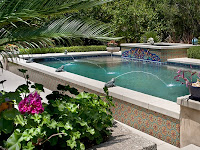Basic Training Series episode 2: Swimming Pool Water Chemistry
I like to use what Bob Lowry teaches, "Target Chemistry," and his recommended target numbers are here. Not a range but a specific number to shoot for.
Sanitizer 3.0 ppm
After the Alkalinity & pH are brought into range, the following adjustment is the Sanitizer. Liquid Chlorine or Bleach is the most common and least expensive of the available sanitizers. The acceptable range is 1.5 - 3 ppm, though 4 - 5 ppm is good. A commercial spa should be maintained at much higher levels - 5 - 6 ppm. Bob Lowry has the Target at 3.0 ppm, so always aim for that for your residential pool.
A residential pool should be maintained at 3.0 ppm. Higher levels ( 4 - 5 ppm) should be established before a large party or heat spell. Try not to allow the groups to drop below three ppm, as this will prevent the need to shock or take other corrective action after the party.
ALKALINITY 90 ppm
There are a number of factors that contribute to the "balance of the water." The most important are the pH and the Alkalinity. Alkalinity is the ability of the water to buffer the pH (or buffer chemicals that may affect the pH). The Alkalinity is like an auto-pilot or cruise control for the pH.
If the Alkalinity is out of the acceptable range, then any tiny factor will cause a wild swing in the pH. This is called "pH bounce." Because of this, the Alkalinity is the first thing that should be brought into line when balancing the water.
An ideal range for the Alkalinity is 100-120 ppm (though 80 - 140 ppm is acceptable).
pH 7.5
The pH of the water determines if it is acidic or basic. Either extreme can have disastrous effects on the pool finish, equipment, or plumbing. When the pH is out of range, bathers may complain of eye discomfort or other ailments.
An acidic pH will cause the water to become aggressive. It will etch the plaster and cement finishes around the pool. Worse yet, it will dissolve the metallic components of the pool. The copper heat exchanger within the pool heater is the most expensive metallic component.
The ideal range for the pH is 7.4 - 7.6 (though 7.2 - 7.8 is acceptable).
HIGH OR LOW TOTAL ALKALINITY:
Total Alkalinity will determine the speed and ease of PH change.
If the starting PH is 7.6 in a 15,000-gallon pool and the Alkalinity is 120 ppm, adding 1 pint of Muriatic Acid will drop the PH to 7.0 and the Alkalinity to 105.
If the starting PH is 7.6 in a 15,000-gallon pool and the Alkalinity is 60 ppm, adding 1 pint of Acid will drop the PH to 6.7 and the Alkalinity to 26 ppm.
So, keeping the Alkalinity in the excellent range of 80-120 ppm is essential. Alkalinity determines the water's ability to neutralize the Acid.
Low Alkalinity will cause:
Etched Plaster
Corroded Metals
Stained plaster
PH to creep, drift lower
Eye & skin irritation
High total Alkalinity will cause:
Scale formation
Cloudy water
Difficulty changing PH or the PH will drift up
Eye & skin irritation
So, to adjust high alkalinity, you want to use muriatic acid or dry acid. When doing this, it is essential to test the acid demand before lowering the total Alkalinity. Never add more than ½ gallon of Acid, and don't add Acid more than three times in one day.
If the total Alkalinity is high in a matter of hours, the PH will rise. This happens because high total Alkalinity will neutralize the Acid. High Alkalinity will create a constant high acid demand.
RAISING Total Alkalinity:
Use SODIUM BICARB (Alkalinity Up {Baking Soda]) to raise Alkalinity without raising the PH. Soda Ash will raise both at the same time. 20 oz of Alkalinity Up will raise your Alkalinity by ten ppm (10,000 gallons).
One final note: the type of Sanitizer you use will determine your total Alkalinity level.
If you use Trichlor 3" tablets, gas chlorine, or bromine, the Alkalinity should be kept in a higher range as each time these are added, it will lower the total Alkalinity.
A neutral sanitizer like Dichlor (granular chlorine) will not raise or lower total alkalinity, so keep it at 100 ppm.
High PH sanitizers like liquid chlorine and cal hypo (shock) will raise your pH and total alkalinity, so keep them in the low range of 80-100 ppm.
Cyanuric Acid (Conditioner) 50 ppm
You add this to your pool water to protect the chlorine from being burned off rapidly from the Sun's UV rays. The chlorine will only last hours without Cyanuric acid (CYA) in your pool water. The chlorine can last 5-10 times longer with the proper level.
The ideal range is 30-50 ppm, although it is okay if it is 80-100 ppm. If it is any higher, the chlorine becomes less effective, and you will need more significant amounts of sanitizer in the water to maintain the chlorine level.
Note that Trichlor tablets and Dichlor will both add significant amounts of CYA to your pool water. Limit the use of these, or your CYA can rise above 150 ppm or higher in one season.
Calcium Hardness 350 ppm
Your water source mainly determines this. The pool's calcium hardness will be high if your fill water is hard. The Ideal range varies with surface type, but 200-400 ppm is acceptable.
If your Hardness is low:
Water balancing will be difficult
Etching of plaster
Corrosion of pool equipment
Eye and skin irritation
Foaming
To raise the calcium hardness, add calcium chloride.
High Hardness:
Scale formation on pool and equipment
Cloudy water
Eye & skin irritation
Water balancing will be difficult
To lower calcium hardness, you will need to drain all or some of the water and refill the pool.
Visit my Website: http://www.swimmingpoollearning.com/
eBook: https://www.swimmingpoollearning.com/swimming-pool-care-ebook

Comments
Post a Comment